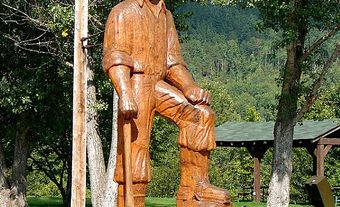The Mattawa River rises in Trout Lake in north-central Ontario, 198.5 m above sea level and drops to 50 m over around 65 km distance to the Ottawa River. Its watershed encompasses 1170 km2 of the Canadian Shield.
History
The Mattawa River is part of a traditional Indigenous route linking the St. Lawrence River with the upper Great Lakes. Indigenous peoples’ presence in the area date as far back as 9,600 years ago. Mattawa is an Algonquian word meaning "junction of waterways" or "river with walls that echo its current."
The Algonquin led the first European travellers into the interior of the continent by way of the Mattawa River. In 1610, Étienne Brûlé was the first non-Indigenous person to see the river. As it had been for Indigenous peoples, the Mattawa River became the major westbound highway for the European traders and missionaries who came after Samuel de Champlain. Alexander Mackenzie called the Mattawa "La Petite Rivière" (the little river) and considered it the most difficult section of the entire trans-continental fur-trade route. (See Fur Trade in Canada.)
Heritage
In 1988, a section of the Mattawa (43 km) was designated a Canadian Heritage River. In 2002, the historic 11 km La Vase Portages was designated. It crosses the height of land between waters flowing east to the Ottawa River and west to Georgian Bay. (See Portage.) Nine of the original eleven La Vase portages are much as they were found by the voyageurs and still have their original French names.
Modern-Day Use
Today, the Mattawa is still a busy canoe route, where recreational paddlers follow portages unchanged for over 300 years. Two provincial parks, the Mattawa River Provincial Park and the Samuel de Champlain Provincial Park (see also Samuel de Champlain) protect most of its course. The town of Mattawa, Ontario, lies at its mouth.

 Share on Facebook
Share on Facebook Share on X
Share on X Share by Email
Share by Email Share on Google Classroom
Share on Google Classroom

